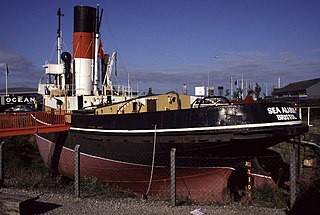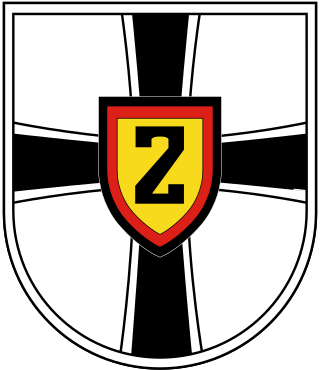
Aktien-Gesellschaft „Weser" was one of the major German shipbuilding companies, located at the Weser River in Bremen. Founded in 1872 it was finally closed in 1983. All together, A.G. „Weser" built about 1,400 ships of different types, including many warships. A.G. „Weser" was the leading company in the Deutsche Schiff- und Maschinenbau AG, a cooperation of eight German shipbuilding companies between 1926 and 1945.

Heligoland is a small archipelago in the North Sea. A part of the German state of Schleswig-Holstein since 1890, the islands were historically possessions of Denmark, then became the possessions of the United Kingdom from 1807 to 1890, and briefly managed as a war prize from 1945 to 1952.

The Swedish Navy is the naval branch of the Swedish Armed Forces. It is composed of surface and submarine naval units – the Fleet – as well as marine units, the Amphibious Corps.

SMS Helgoland, the lead ship of her class, was a dreadnought battleship of the German Imperial Navy. Helgoland's design represented an incremental improvement over the preceding Nassau class, including an increase in the bore diameter of the main guns, from 28 cm (11 in) to 30.5 cm (12 in). Her keel was laid down on 11 November 1908 at the Howaldtswerke shipyards in Kiel. Helgoland was launched on 25 September 1909 and was commissioned on 23 August 1911.

Howaldtswerke-Deutsche Werft is a German shipbuilding company, headquartered in Kiel. It is part of the ThyssenKrupp Marine Systems (TKMS) group, owned by ThyssenKrupp. The Howaldtswerke shipyard was founded in Kiel in 1838 and merged with Hamburg-based Deutsche Werft to form Howaldtswerke-Deutsche Werft (HDW) in 1968. The company's shipyard was formerly used by Friedrich Krupp Germaniawerft until the end of World War II.
Heligoland is a German island in the North Sea.

The Belgian Navy, officially the Naval Component of the Belgian Armed Forces, is the naval service of Belgium.

The Helgoland class was the second class of dreadnought battleships to be built for the German Kaiserliche Marine. Constructed from 1908 to 1912, the class comprised four ships: Helgoland, the lead ship; Oldenburg; Ostfriesland; and Thüringen. The design was a significant improvement over the previous Nassau-class ships; they had a larger main battery—30.5 cm (12 in) main guns instead of the 28 cm (11 in) weapons mounted on the earlier vessels—and an improved propulsion system. The Helgolands were easily distinguished from the preceding Nassaus by the three funnels that were closely arranged, compared to the two larger funnels of the previous class. The ships retained the hexagonal main battery layout of the Nassau class.

SMS Schwaben was the fourth ship of the Wittelsbach class of pre-dreadnought battleships of the German Imperial Navy. Schwaben was built at the Imperial Dockyard in Wilhelmshaven. She was laid down in 1900, and completed in April 1904. Her sister ships were Wittelsbach, Zähringen, Wettin and Mecklenburg; they were the first capital ships built under the Navy Law of 1898, championed by Admiral Alfred von Tirpitz. Schwaben was armed with a main battery of four 24-centimeter (9.4 in) guns and had a top speed of 18 knots.

An emergency tow vessel, also called emergency towing vessel, (ETV) is a multi purpose boat used by state authorities to tow disabled vessels on high seas in order to prevent dangers to man and environment. The disabled vessel is either towed to a safe haven or kept in place against wind and current until commercial assistance by tug boats has arrived on site or until it has been repaired to the extent of being able to manoeuvre on its own. The need for ETVs as a preventive measure has arisen since the number of available commercial salvage tugs was reduced while potential dangers from individual vessels have increased. E.g. Spain has fourteen, Turkey has eleven, Germany operates eight, Norway has seven, France has five, Sweden three and the Netherlands, Poland, South Africa, Iceland and Finland each have one official emergency tug boat. Australia also operates emergency response vessels. The United Kingdom's four strong ETV fleet was to be disbanded in September 2011 due to budget cuts but the two vessels operating in Scottish waters received an extension of contract until the end of 2011.

Heligoland Lighthouse is located on Germany's only offshore island, Heligoland. Constructed during World War II as an anti-aircraft tower, it was turned into a lighthouse in 1952. It features the strongest light on the German North Sea coast with a range of 28 nautical miles (52 km) so that it can be seen as far as on the East Frisian or the North Frisian islands and Halligen. The lighthouse is operated by the Tönning water and shipping authority.

Admiralty tugs were tugboats built for and operated by the Royal Navy. These were vessels built to Admiralty specifications and in specific classes during the First and Second World Wars. They were built to meet the Royal Navy's demand for auxiliary vessels and to supplement the civilian tugs requisitioned by the Admiralty for war service.
The RV MTA Sismik 1 is a decommissioned Turkish research vessel belonging to Istanbul Technical University. She is operated by its Faculty of Maritime for training purposes. Originally, she was owned by the General Directorate of Mineral Research and Exploration (MTA) in Ankara and operated by its division of Geophysical Directorate for subsea geophysical exploration.

SMS Helgoland was a Novara-class scout cruiser built for the Austro-Hungarian Navy right before World War I. Helgoland participated in several raids on the ships defending the Strait of Otranto, including the Battle of the Strait of Otranto in May 1917. She was transferred to Italy in 1920 in accordance with the peace treaties ending World War I and renamed Brindisi. After modifications, the ship was assigned to the squadron responsible for the Eastern Mediterranean until 1924. She spent the next five years based in Libya and Italy before Brindisi was disarmed and turned into a depot ship in 1929. The ship was stricken from the Navy List in 1937 and later broken up.
Several naval ships were named Helgoland after the island of Heligoland or the Battle of Helgoland, an action during the Second Schleswig War.

Einsatzflottille 2 is one of the three brigade-level units of the German Navy, in addition to Einsatzflottille 1 and the Naval Air Command. It is based in Wilhelmshaven, Lower Saxony, and is subordinated to Navy Command, based in Rostock.

The Novara class was a class of three scout cruisers built for the Austro-Hungarian Navy. Named for the Battle of Novara, the class comprised SMS Saida, SMS Helgoland, and SMS Novara. Construction started on the ships shortly before World War I; Saida and Helgoland were both laid down in 1911, Novara followed in 1912. Two of the three warships were built in the Ganz-Danubius shipyard in Fiume; Saida was built in the Cantiere Navale Triestino shipyard in Monfalcone. The Novara-class ships hold the distinction for being the last cruisers constructed by the Austro-Hungarian Navy.













